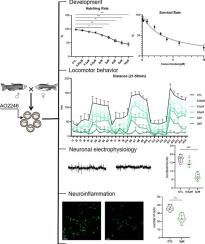Science of the Total Environment ( IF 8.2 ) Pub Date : 2023-08-14 , DOI: 10.1016/j.scitotenv.2023.166306 Yinan Chai 1 , Donglai Sheng 2 , Xiaowei Ji 3 , Yanlong Meng 4 , Feihao Shen 1 , Rui He 5 , Runjia Ma 6 , Yuying Wang 1

|
Background
2,2′-Methylenebis (4-methyl-6-tert-butylphenol) (AO2246) is a synthetic phenolic antioxidant extensively used in food packaging bags and cosmetics. Recently, AO 2246 was detected with unexpectedly high concentrations in plasma and breast milk samples from pregnant and lactating women. Hence, it is essential to conduct a thorough investigation to evaluate the detrimental effects of AO2246 on biota.
Objective
To investigate the developmental and behavioral toxicity of AO2246 in zebrafish, as well as the molecular mechanisms underlying these effects.
Methods
Zebrafish embryos were exposed to AO2246 at concentrations ranging from 0.05 to 10 μM for up to 6 days postfertilization (dpf). Hatching rate, survival rate, heart rate, and body length were measured. Locomotor behavioral and electrophysiologal analyses were performed. Two fluorescence-labeled transgenic zebrafish lines (endothelium-Tg and macrophage/microglia-Tg) were employed. RNA sequencing was carried out.
Results
AO2246 has a 96-hour LC50 value of 3 μM. The exposure of AO2246 resulted in a significant reduction in both hatching rate and heart rate. Analysis of locomotor behavior demonstrated that larvae exposed to AO2246 doses exceeding 2 μM exhibited a significant decrease in both total distance and mean velocity. Electrophysiological recordings demonstrated a noteworthy reduction in spike activity at a concentration of 3 μM, relative to control conditions. The administration of AO2246 at 3 μM elicited morphological reactivity and immune alteration of the midbrain microglia in the macrophage/microglia-transgenic zebrafish line, indicating a potential contribution of neurological disorders to behavioral defects. RNA sequencing analysis revealed altered gene expression profiles at high AO2246 concentrations, particularly the dysregulation of pathways associated with neuronal function.
Conclusions
The present study demonstrates that AO2246 exposure elicits developmental and neurobehavioral toxicity in zebrafish larvae. Specifically, exposure to AO2246 was found to cause disturbances in neuronal electrophysiological activity and neurological disorders, which ultimately led to the impairment of locomotor behavior in zebrafish larvae.
中文翻译:

2,2′-亚甲基双(6-叔丁基-4-甲基苯酚)(抗氧化剂 AO2246)在斑马鱼生命早期阶段的发育和神经行为毒性
背景
2,2′-亚甲基双(4-甲基-6-叔丁基苯酚)(AO2246)是一种合成酚类抗氧化剂,广泛用于食品包装袋和化妆品。最近,在孕妇和哺乳期妇女的血浆和母乳样本中检测到 AO 2246 的浓度出乎意料地高。因此,有必要进行彻底的调查来评估 AO2246 对生物群的有害影响。
客观的
研究 AO2246 对斑马鱼的发育和行为毒性,以及这些效应背后的分子机制。
方法
斑马鱼胚胎在受精后 (dpf) 内暴露于浓度范围为 0.05 至 10 μM 的 AO2246 中长达 6 天。测量孵化率、存活率、心率和体长。进行运动行为和电生理分析。采用两种荧光标记的转基因斑马鱼系(内皮细胞-Tg 和巨噬细胞/小胶质细胞-Tg)。进行了RNA测序。
结果
AO2246 的 96 小时 LC 50值为 3 μM。暴露于 AO2246 会导致孵化率和心率显着降低。运动行为分析表明,暴露于超过 2 μM AO2246 剂量的幼虫的总距离和平均速度均显着下降。电生理记录表明,相对于对照条件,浓度为 3 μM 时尖峰活性显着降低。施用 3 μM AO2246 引起巨噬细胞/小胶质细胞转基因斑马鱼系中中脑小胶质细胞的形态反应和免疫改变,表明神经系统疾病可能导致行为缺陷。RNA测序分析揭示了高AO2246浓度下基因表达谱的改变,特别是与神经元功能相关的通路的失调。
结论
本研究表明,AO2246 暴露会引起斑马鱼幼虫的发育和神经行为毒性。具体而言,发现暴露于 AO2246 会导致神经元电生理活动紊乱和神经系统疾病,最终导致斑马鱼幼虫的运动行为受损。































 京公网安备 11010802027423号
京公网安备 11010802027423号